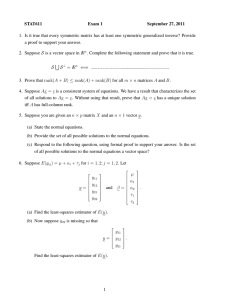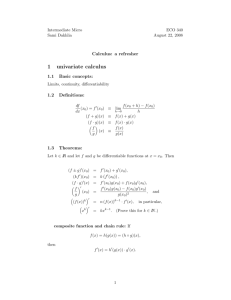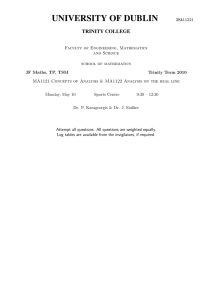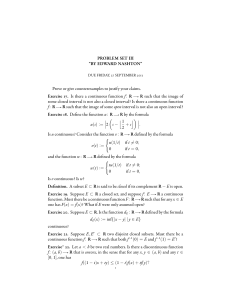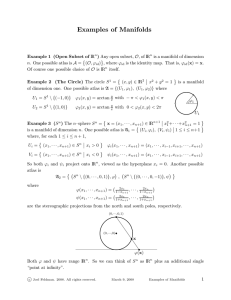A KACZMARZ-KOVARIK ALGORITHM FOR SYMMETRIC ILL-CONDITIONED MATRICES ∗
advertisement
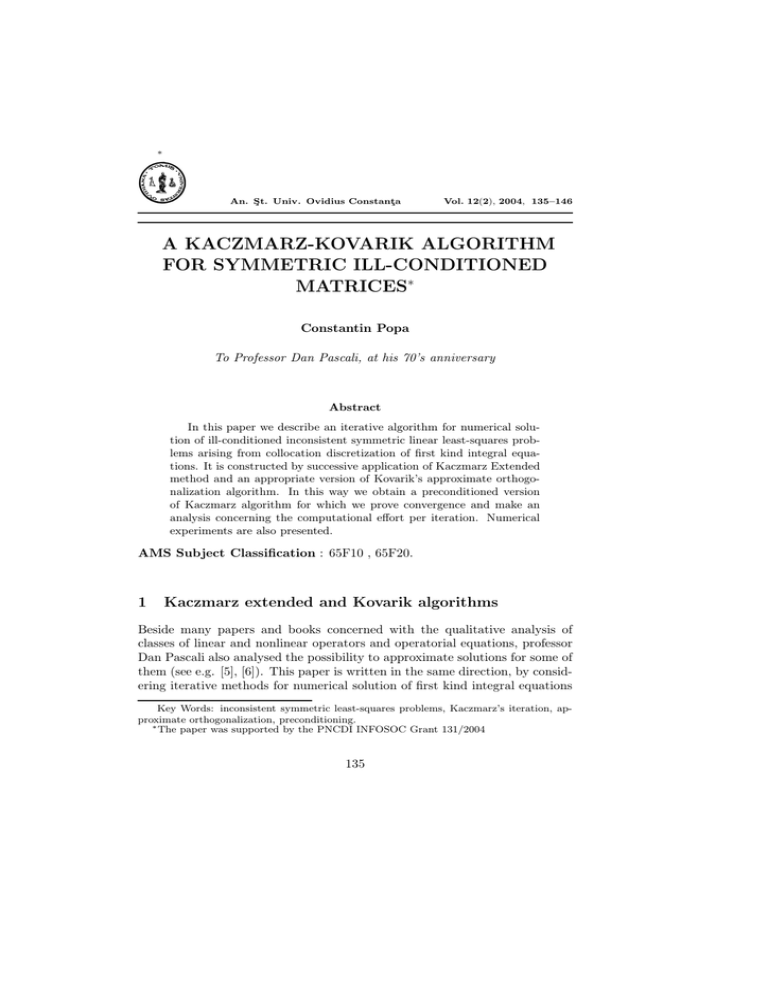
∗
An. Şt. Univ. Ovidius Constanţa
Vol. 12(2), 2004, 135–146
A KACZMARZ-KOVARIK ALGORITHM
FOR SYMMETRIC ILL-CONDITIONED
MATRICES∗
Constantin Popa
To Professor Dan Pascali, at his 70’s anniversary
Abstract
In this paper we describe an iterative algorithm for numerical solution of ill-conditioned inconsistent symmetric linear least-squares problems arising from collocation discretization of first kind integral equations. It is constructed by successive application of Kaczmarz Extended
method and an appropriate version of Kovarik’s approximate orthogonalization algorithm. In this way we obtain a preconditioned version
of Kaczmarz algorithm for which we prove convergence and make an
analysis concerning the computational effort per iteration. Numerical
experiments are also presented.
AMS Subject Classification : 65F10 , 65F20.
1
Kaczmarz extended and Kovarik algorithms
Beside many papers and books concerned with the qualitative analysis of
classes of linear and nonlinear operators and operatorial equations, professor
Dan Pascali also analysed the possibility to approximate solutions for some of
them (see e.g. [5], [6]). This paper is written in the same direction, by considering iterative methods for numerical solution of first kind integral equations
Key Words: inconsistent symmetric least-squares problems, Kaczmarz’s iteration, approximate orthogonalization, preconditioning.
∗ The paper was supported by the PNCDI INFOSOC Grant 131/2004
135
Constantin Popa
136
of the form (see also the last section of the paper)
1
k(s, t)x(t)dt = y(s), s ∈ [0, 1].
0
In this respect, the rest of this introductory section will be concerned with the
description of the original versions of these methods. Let A be an n × n real
symmetric matrix. We shall denote by (A)i , r(A), R(A), N (A), bi the i-th
row, rank, range, null space of A and i-th component of b, respectively (all
the vectors that appear being considered as column vectors). The notations
ρ(A), σ(A) will be used for the spectral radius and spectrum of A and A =
ρ(A) will be the spectral norm. PS will be the orthogonal projection onto
the vector subspace S, with respect to the Euclidean scalar product and the
associated norm, denoted by ·, · and · , respectively. We shall consider a
vector b ∈ IRn and the linear least-squares problem : find x∗ ∈ IRn such that
Ax∗ − b = min!
(1)
It is well known (see e.g. [1]) that the set of all (least-squares) solutions of (1),
denoted by LSS(A; b) is a nonempty closed convex subset of IRn containing
a unique solution with minimal norm, denoted by xLS . Moreover, if bA =
PR(A) (b) we have
(2)
x∗ ∈ LSS(A; b) ⇔ Ax = bA .
If A has nonzero rows, i.e.
(A)i = 0, i = 1, . . . , n,
(3)
we define the applications (matrices)
fi (A; b; x) = x −
< x, (A)i > − bi
< y, (A)i >
(A)i , Pi (A; y) = y −
(A)i , (4)
(A)i 2
(A)i 2
K(A; b; x) = (f1 ◦ · · · ◦ fn )(A; b; x), Φ(A; y) = (P1 ◦ · · · ◦ Pn )(A; y),
(5)
for x, y ∈ IRn and R the real n × n matrix of which i-th column (R)i is given
by
1
(R)i =
P1 P2 . . . Pi−1 ((A)i ),
(6)
(A)i 2
with P0 = I (the unit matrix). According to [11] (for symmetric matrices) we
have the following results.
Proposition 1 (i) We have
K(A; b; x) = Qx + Rb, Q + RA = I, Rx ∈ R(A), ∀ x ∈ IRn .
(7)
A KACZMARZ-KOVARIK ALGORITHM
137
(ii) N (A) and R(A) are invariant subspaces for Φ and
Φ = PN (A) ⊕ Φ̃, PN (A) Φ̃ = Φ̃PN (A) = 0,
(8)
where Φ̃ is the linear application defined by
Φ̃ = ΦPR(A) .
(9)
(iii) The application Φ̃ satisfies
Φ̃ =
ρ(Φ̃t Φ̃) < 1.
(10)
The following extension of the original Kaczmarz’s projections method will be
considered (see [2], [7]).
Algortihm KE. Let x0 ∈ IRn , y 0 = b; for k = 0, 1, . . . do
y k+1 = Φ(A; y k ), β k+1 = b − y k+1 , xk+1 = K(A; β k+1 ; xk ).
(11)
Next theorem, proved in [8] explains the convergence behaviour of the algorithm KE.
Theorem 1 Let G be the n × n matrix defined by
G = (I − Φ̃)−1 R.
(12)
Then, for any matrix A satisfying (3) any b ∈ IRn and x0 ∈ IRn , the sequence
(xk )k≥0 generated with the algorithm (11) converges,
lim xk = PN (A) (x0 ) + GbA
k→∞
(13)
and the following equalities hold
LSS(A; b) = {PN (A) (x0 ) + GbA , x0 ∈ IRn }, xLS = GbA .
(14)
Remark 1 The first and third steps from (11) consist on succesive orthogonal
projections onto the hyperplanes generated by the rows of A (see (4)-(5)).
Then, faster will be the convergence of the algorithm (11) if the values of the
angles between columns and rows will be closer to 90◦ (see e.g. [11]).
According to the above Remark 1, we will consider the Inverse-free modified
Kovarik algorithm from [3] (denoted in what follows by KOS). For this we
shall suppose in addition that A is positive semidefinite and
σ(A) ⊂ [0, 1).
(15)
Constantin Popa
138
Let aj , j ≥ 0 be the coefficients of the Taylor’s expansion
1
√
= a0 + a1 x + . . . , x ∈ (−1, 1),
1−x
(16)
i.e.
a0 = 1, aj+1 =
2j + 1
aj , j ≥ 0
2j + 2
(17)
and, for a given integer q ≥ 1 the truncated Taylor’s series S(Ak ; q) defined
by
q
ai (−Ak )i .
(18)
S(Ak ; q) =
i=0
Algorithm KOS Let A0 = A ; for k = 0, 1, . . . , do
Kk = (I − Ak )S(Ak ; nk ), Ak+1 = (I + Kk )Ak ,
(19)
where nk , k ≥ 0 is a sequence of positive integers.
Next theorem (see [4]) analyses the convergence properties of the algorithm
KOS.
Theorem 2 Let A be symmetric and positive semidefinite such that (15)
holds. Then the sequence of matrices (Ak )k≥0 generated by the above algorithm
KOS converges to A∞ = A+ A, where A+ is the Moore-Penrose pseudoinverse.
Moreover, the convergence is linear, i.e.
Ak − A∞ 2 ≤ γ k A − A∞ 2 , ∀k ≥ 0,
(20)
1
λmin (A)
γ = max{1 − λmin (A) + λmin (A)2 , 1 − },
2
1 + λmin (A)
(21)
with
where by λmin (A) we denoted the minimal nonzero eigenvalue of A.
Remark 2 The assumption (15) is not restrictive; it can be easy obtained be
scalling the matrix coefficients in an appropriate way. Moreover, during the
application of KOS an approximate orthogonalization of the rows of A occurs
(see for details [10]); in this sense and according to the comments in Remark
1 before, KOS will be used as a preconditioner for KE as will be described in
the next section of the paper.
A KACZMARZ-KOVARIK ALGORITHM
2
139
The preconditioned Kaczmarz algorithm
According to the results and comments from the previus section, we propose
the following preconditioned Kaczmarz algorithm.
Algorithm PREKAZ. Let x0 ∈ IRn , A0 = A, b0 = b and
K0 = (I − A0 )S(A0 ; n0 );
(22)
for k = 0, 1, 2, . . . do
Step 1. Compute Ak+1 and bk+1 by
Ak+1 = (I + Kk )Ak , bk+1 = (I + Kk )bk ,
(23)
Step 2. Compute y k+1 and β k+1 by
y k+1 = Φk+1 (Ak+1 ; bk+1 ),
(24)
β k+1 = bk+1 − y k+1 .
(25)
k+1
Step 3. Compute the next approximation x
by
xk+1 = K(Ak+1 ; β k+1 ; xk )
(26)
and update Kk to Kk+1 by
Kk+1 = (I − Ak+1 )S(Ak+1 ; nk+1 ).
(27)
Remark 3 The step (24) means succesive application of Φ(Ak+1 ; ·)
(k + 1) - times to the initial vector bk+1 , i.e.
Φk+1 (Ak+1 ; bk+1 ) = (Φ(Ak+1 ; ·) ◦ · · · ◦ Φ(Ak+1 ; ·))(bk+1 ).
(28)
This aspect will be analysed in section 3.
Remark 4 From (23) and because the matrices I + Kk are symmetric and
positive definite ∀k ≥ 0, we obtain easy that
N (Ak ) = N (A), LSS(Ak ; bk ) = LSS(A; b), ∀ k ≥ 0.
(29)
In what follows we shall prove convergence for the above algorithm PREKAZ.
For this, let Φk , Φ̃k , Rk and Gk be the matrices defined as in (5), (9), (6), (12),
respectively, but with Ak from (23) instead of A, bk as in (23) and bkAk defined
by
(30)
bkAk = PR(Ak ) (bk ).
For proving our convergence result we need an auxiliary one which will be
presented below.
Constantin Popa
140
Proposition 2 (i) If Φ̃∞ and R∞ are the matrices defined as in (9) and (6),
respectively but with A∞ from theorem 2 instead of A, then
lim Φ̃k = Φ̃∞ ,
k→∞
lim Rk = R∞ .
k→∞
(31)
(ii) The sequence (bkAk )k≥0 from (30) is bounded.
Proof. (i) It results as in the proof of Theorem 1 from [10].
(ii) If our conclusion would be false, it would exist a subsequence of (bkAk )k≥0
(which, for simplicity we shall denote in the same way) such that
lim bkAk = +∞.
k→∞
(32)
But, from (2) and (30) we have the equivalence x ∈ LSS(Ak ; bk ) ⇔ Ak x = bkAk .
Then, for any x∗ ∈ LSS(A; b) we obtain (also using (29))
Ak x∗ = bkAk , ∀ k ≥ 0.
(33)
But, from Theorem 2 we have that limk→∞ Ak = A∞ , which tells us that it
exists an integer k0 ≥ 1 such that
Ak x∗ ≤ A∞ x∗ + 1, ∀ k ≥ k0 .
(34)
Now, if k1 ≥ k0 ≥ 1 is an integer such that (see (32))
bkAk > A∞ x∗ + 1, ∀ k ≥ k1 ,
then by also using (33) and (34) we get a contradiction which completes our
proof.
Theorem 3 For any x0 ∈ IRn if (xk )k≥0 is the sequence generated with the
algorithm (22)-(27), then
lim xk = PN (A) (x0 ) + GbA .
k→∞
(35)
Proof. Let k ≥ 0 be arbitrary fixed and bk∗ ∈ IRn defined by
bk∗ = PN (Ak ) (bk ).
(36)
Then, we have the orthogonal decomposition of bk (see (30))
bk = bkAk ⊕ bk∗
(37)
LSS(Ak ; bk ) = {PN (Ak ) (x0 ) + Gk bkAk , x0 ∈ IRn },
(38)
as in [8] we obtain
A KACZMARZ-KOVARIK ALGORITHM
xLS = Gk bkAk = GbA ,
141
(39)
together with (by also using (29))
PN (Ak ) (xk ) = PN (A) (xk ) = PN (A) (x0 ), ∀ k ≥ 0,
(40)
for an arbitrary fixed initial approximation x0 ∈ IRn . Using (40) together with
(39), (7), (26), (8), we succesively get
xk+1 − (PN (A) (x0 ) + GbA ) = xk+1 − (PN (Ak+1 ) (x0 ) + Gk+1 bk+1
Ak+1 ) =
(PN (Ak+1 ) (xk ) + Φ̃k+1 xk + Rk+1 β k+1 ) − (PN (Ak+1 ) (xk ) + Gk+1 bk+1
Ak+1 ) =
Φ̃k+1 xk + Rk+1 β k+1 − [(I − Φ̃k+1 ) + Φ̃k+1 ][(I − Φ̃k+1 )−1 Rk+1 ]bk+1
Ak+1 =
k+1
0
Φ̃k+1 xk + Rk+1 β k+1 − Rk+1 bk+1
Ak+1 − Φ̃k+1 Gk+1 bAk+1 − Φ̃k+1 PN (Ak+1 ) (x ) =
Φ̃k+1 [xk − (PN (A) (x0 ) + GbA )] + Rk+1 (β k+1 − bk+1
Ak+1 ).
(41)
Now, from (25), (37), (24), (8) and (36) we obtain
k+1
k+1
β k+1 −bk+1
−y k+1 −bk+1
−y k+1 = bk+1
−Φk+1 (Ak+1 ; bk+1 ) =
∗
Ak+1 = b
Ak+1 = b∗
− [PN (Atk+1 ) ⊕ Φ̃k+1 ]k+1 (bk+1 ) = bk+1
− [PN (Atk+1 ) ⊕ (Φ̃k+1 )k+1 ](bk+1 ) =
bk+1
∗
∗
[bk+1
− PN (Atk+1 ) (bk+1 )] − (Φ̃k+1 )k+1 (bk+1 ) =
∗
−(Φ̃k+1 )k+1 (bk+1 ) = −(Φ̃k+1 )k+1 (bk+1
Ak+1 ).
(42)
Let x∗ ∈ IRn be defined by ( see (35))
x∗ = PN (A) (x0 ) + GbA .
(43)
Then, from (41) and (42) we obtain
xk+1 − x∗ = Φ̃k+1 (xk − x∗ ) − Rk+1 (Φ̃k+1 )k+1 (bk+1
Ak+1 ), ∀ k ≥ 0.
By iterating the equality (44) we get
xk+1 − x∗ = Φ̃k+1 . . . Φ̃1 (x0 − x∗ )−
k
j=1
Φ̃k+1 . . . Φ̃j+1 Rj (Φ̃j )j (bjAj ) − Rk+1 (Φ̃k+1 )k+1 (bk+1
Ak+1 ),
thus, by taking norms
xk+1 − x∗ ≤ Φ̃k+1 . . . Φ̃1 x0 − x∗ +
(44)
Constantin Popa
142
k
j=1
( Φ̃k+1 . . . Φ̃j+1 Φ̃j j Rj bjAj )+
Rk+1 Φ̃k+1 k+1 bk+1
Ak+1 .
(45)
From (10) we obtain that
Φ̃k < 1, ∀ k ≥ 0, Φ̃∞ < 1.
(46)
Let then k0 ≥ 1 and M0 > 0 be such that
Φ̃k <
1+ Φ̃∞ < 1,
2
Rk < R∞ + 1,
(47)
bk+1
Ak+1 ≤ M0 , ∀ k > k0
(48)
(such k0 and M0 exist according to (31), (46) and Proposition 2(ii)). Let now
µ ∈ (0, 1) and M > 0 be defined by
µ = max{ Φ̃1 , . . . , Φ̃k0 ,
1+ Φ̃∞ },
2
(49)
M = max{ R1 , . . . , Rk0 , R∞ + 1, b0A0 , . . . , bkA0k , M0 }. (50)
0
Then, from (45)-(50) we get
xk+1 − x∗ ≤ µk+1 ( x0 − x∗ +M 2 (k + 1)), ∀ k ≥ 0,
(51)
thus limk→∞ xk+1 − x∗ = 0 and the proof is complete.
Corollary 1 In the above hypothesis, for any x0 ∈ IRn the sequence (xk )k≥0
generated with the algorithm PREKAZ converges to a solution of the problem
(1). Moreover, it converges to the minimal norm solution xLS if and only if
x0 ∈ R(A).
3
Some computational aspects
The step (24) of the above algorithm (in which we must apply k-times the
application Φ (Ak ; ·)) requires a big computational effort (see also Remark 3).
Indeed, if M is the number of iterations of (22) - (27) to obtain some accuracy,
then the total number of applications of Φ (Ak ; ·) in (24), denoted by N S, is
NS =
M (M + 1)
,
2
(52)
A KACZMARZ-KOVARIK ALGORITHM
143
which, even for small values of M can be enough big (see the last section of
the paper). In order to improve this we can try to replace Φk in (24), by Φf (k) ,
where f : (0, ∞) → (0, ∞) is a function such that the following assumptions
are fulfiled:
(i) the algorithm (22) - (27) still converges and with ”almost the same” convergence rate (see (51);
(ii) the total number of applications of Φ(Ak ; ·) in (24), denoted by N S(f )
and given by
M
f (k)
(53)
N S(f ) =
k=1
satisfies
N S(f ) < N S
(54)
(in (24) we have f (k) = k, ∀k ≥ 1). In this sense, by also taking into account
(51) we formulate the following problem: for a given number γ ∈ (0, 1), find
f as before, such that
γ f (k) < +∞
(55)
k≥1
and (54) holds. The following three results give possible answers to the above
request (55) (for the proof see [9]).
Theorem 4 (i) If a > 0, a = 1 the series k≥1 γ [loga k] converge if and only
if a ∈ (1, γ1 );
a
(ii) if a ∈ (γ, ∞) then the series k≥1 γ [k ] converge;
k
(iii) if a ∈ ( γ1 , ∞) then the series k≥1 γ [a ] converge, where by [x] we denoted
the integer part of the real number x.
Remark 5 We will see in the following section of the paper that, for some
values of a the choices of f as in theorem 4 before, also satisfy the assumption
(55).
4
Numerical experiments
We considered in our numerical experiments the following first kind integral
equation: for a given function y ∈ L2 ([0, 1]), find x ∈ L2 ([0, 1]) such that
0
1
k(s, t)x(t)dt = y(s), s ∈ [0, 1].
(56)
Constantin Popa
144
We discretized (56) by a collocation algorithm with the collocation points (see
e.g. [10])
1
, i = 1, 2, . . . , n,
si = (i − 1)
n−1
and we obtained a symmetric system
Ax = b,
with the n × n matrix A and b ∈ IRn given by
1
Aij =
k(si , t)k(sj , t)dt, bi = y(si ).
(57)
(58)
0
We considered the following data
k(s, t) =
1
2.5 − s
, y(s) = ln
,
1 + |s − 0.5| + t
1.5 − s
s ∈ [0, 0.5) ln 1.5 + s 0.5+s, s ∈ [0.5, 1] (59)
where the right hand side y was computed such that the equation (56) has the
solution x(t) = 1, ∀t ∈ [0, 1]. Then, from (58) we obtained
1
1
Aij =
, if
k(si , t)k(sj , t)dt =
α
(1
+ αi )
i
0
αi = αj ,1
(1+α )α
αi −αj ln (1+αj )α i ,if
i
j
αi = αj
bi = y(si ), (60)where
αi = 1 + si −
1 , i = 1, . . . , n.
2
(61)
For n ≥ 3, the rank of the matrix A is given by
rank(A) =
n+1
, if
2
nisodd n2 , ifniseven.(62)First of all we have to observe that, because the problem (56) with the data (59) is consistent, it results that the system (57) is also
consistent. We then applied the algorithm PREKAZ, for different values of n
and different choices for the function f in (53), with the ”residual” stopping
rule
(63)
Axk − b ≤ 10−6 .
The corresponding numbers of iterations are presented in Table 1 below.
A KACZMARZ-KOVARIK ALGORITHM
145
Table 1. Results for the system (57)
n
f (k) = k f (k) = [k 0.8 ] f (k) = [log1.3 k]
8
21
21
21
16
22
22
23
32
22
23
23
64
23
24
24
128
23
24
25
In Table 2 we computed the values N S(f ) from (53) for all the choices for f
from Table 1.
Table 2. Total number of iterations
n
N S(k) N S([k 0.8 ]) N S([log1.3 k])
8
231
139
164
16
253
145
172
32
253
145
172
64
276
161
175
128
276
161
175
We may observe a reduction of the total number of iterations for reaching the
accuracy requested by the stopping rule (63).
Note. All the computations were made with the Numerical Linear Algebra
software package OCTAVE, freely available under the terms of the GNU General Public License, see www.octave.org.
References
[1] Bjork A., Numerical methods for least squares problems, SIAM Philadelphia, 1996.
[2] Kaczmarz S. Angenaherte Auflosung von Systemen linearer Gleichungen,
Bull. Acad. Polonaise Sci. et Lettres A (1937), 355-357.
[3] Kovarik, S., Some iterative methods for improving orthogonality, SIAM
J. Num. Anal., 7(3)(1970), 386-389.
[4] Mohr M., Popa C., Ruede U., A Kovarik type-algorithm without matrix
inversion for the numerical solution of symmetric least-squares problems
; Lehrstuhlbericht 05-2, Lehrstuhl für Informatik 10 (Systemsimulation),
Erlangen-Nürnberg University , Germany, 2005.
[5] Pascali, D., On the approximation of the solution of the equations defined
by potential operators; Stud. Cerc. Math., 23(10)(1971), 1533-1535.
146
Constantin Popa
[6] Pascali, D., Approximation solvability of a semilinear wave equation; Libertas Math., 4(1984), 73-78.
[7] Popa C., Extensions of block-projections methods with relaxation parameters to inconsistent and rank-defficient least-squares problems;
B I T, 38(1)(1998), 151-176.
[8] Popa C., Characterization of the solutions set of inconsistent least-squares
problems by an extended Kaczmarz algorithm; Korean Journal on Comp.
and Appl. Math., vol. 6(1)(1999), 51-64.
[9] Popa C., Some remarks concerning a Kaczmarz-Kovarik algorithm for
inconsistent least-squares problems, in Proceedings of the 7th Conference
on Nonlinear Analysis, Numerical Analysis, Applied Mathematics and
Computer Science, ”Ovidius” Univ. Press, Constanta 2000, 69-74.
[10] Popa, C., A method for improving orthogonality of rows and columns of
matrices, Intern. J. Comp. Math., 77(3)(2001), 469-480.
[11] Tanabe K., Projection Method for Solving a Singular System of Linear
Equations and its Applications, Numer. Math., 17(1971), 203-214.
”Ovidius” University of Constanta
Department of Mathematics and Informatics,
900527 Constanta, Bd. Mamaia 124
Romania
e-mail: cpopa@univ-ovidius.ro

